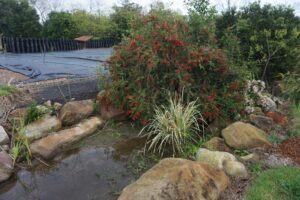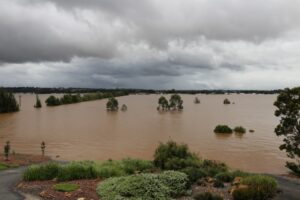
Buffer plants: Wet and dry feet superstars
By Daniel Fuller
The old saying, ‘right plant, right place’ will always be the fundamental rule for horticulture and landscaping. But some plants are ‘right’ for more places than others. At Ozbreed, we’ve bred a range of buffer plants that can handle both the driest and the wettest of soils.
Instead of simply choosing the best looking plants to breed, we’ve put our plants through hell and back to see which ones survived. We tested various plants in extreme flooding over ten years, with six serious flooding events and an extremely irrigated area, over three testing sites in Richmond just outside of Sydney.
If you are looking for plants for difficult environments to recommend to consumers in your nursery or to specify in your landscape plan, the results of our wet feet trials provides you with a core group of bulletproof plants. Plants you can depend on to stand the test of time; we call them buffer plants.

Buffer plants are useful for areas where other plants struggle such as in rain gardens, bioswales, vertical gardens, over-irrigated gardens, and spaces with poor heavy soils or depressions that have drainage issues. They are also useful when you can’t afford for plants to fail.
Tropic Cascade Lomandra hystrix is a cultivar that not only serves as a buffer plant, but also improves the soil stability by 159%, making it perfect for sites that have erosion issues. It survived down to -4°C, looks incredible with its vibrant weeping foliage, and blesses the landscape with fragrant flowers in the warmer months
Westringias aren’t usually known for their ability to tolerate wet feet. In fact they generally struggle when exposed to any sort of extended flood conditions or heavier soil. However, there are a couple of varieties that will not only survive, but thrive.
Mundi Westringia is a low-growing variety that will grow much larger than advertised when it sits with wet feet for extended periods. Grey Box Westringia is a native Buxus alternative that has beautiful silvery-grey foliage that can be used in topiary, formal garden settings, or you can allow it to express its natural shrubby form.
Unlike westringias, bottlebrushes have a reputation for tolerating wet conditions and heavy soils. However, not all varieties perform the same, so their reputation isn’t always earned. The varieties in the attached table tolerate drought and wet conditions, and they are all Myrtle Rust resistant which is a bonus in warmer, humid areas of the country such as Brisbane.
Slim Callistemon is a columnar shaped variety that is perfect for tight planting areas and fast-growing hedges, while Better John and Green John Callistemon are faster-establishing alternatives to Little John, with better characteristics.
With the unpredictable weather patterns we’ve been experiencing over the past few years, and which are likely to continue, buffer plants are the way to go.
When you inlcude these plants in the landscape, you are unlikely to receive complaints from customers and clients when wild weather occurs, helping you to build a loyal, happy customer base due to good advice and successful landscapes. This, in turn, fosters a good reputation for solving customer problems and makes gardening easier for your clients.
There’s often space to experiment with novel plants that are a bit riskier, and for those cases, you can try more delicate specimens.
Some plant varieties that thrive in permanently wet conditions
| Slim™ Callistemon viminalis ‘CV01’ PBR | Macarthur™ Callistemon viminalis ‘LC01’ PBR |
| Better John™ Callistemon viminalis ‘LJ1’ PBR | Green John™ Callistemon viminalis ‘LJ23’ PBR |
| Yalba™ Imperata cylindrica | Isabella® Liriope muscari ‘LIRF’ PBR |
| Just Right® Liriope muscari ‘LIRJ’ PBR | Amethyst™ Liriope muscari ‘LIRTP’ PBR |
| Shara™ Lomandra fluviatilis ‘ABU7’ PBR | Lucky Stripe™ Lomandra hystrix ‘LMV200’ PBR |
| Tropic Cascade™ Lomandra hystrix ‘LHWP’ PBR | Cosmic Pink™ Rhaphiolepis indica ‘RAPH02’ PBR |
| Cosmic White™ Rhaphiolepis indica ‘RAPH01’ PBR | Grey Box™ Westringia fruticosa ‘WES04’ PBR |
| Mundi™ Westringia fruticosa ‘WES05’ PBR | Nafray® Pennisetum alopecuroides |
